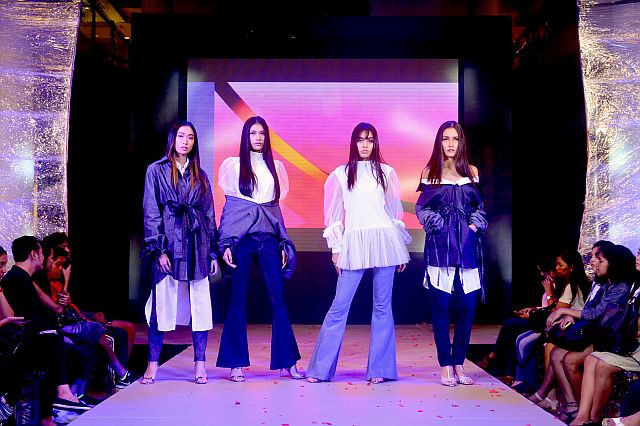
I only heard stilettos trudging—click, clack, click, clack—on the wooden platform when I temporarily dislodged the headset in the middle of the show.
You know, like watching a 3D movie, and then you remove the glasses for awhile during the run just to assure yourself that the images blur without them on. But that is not unintentional here. It’s the show that ushered in the return of the three men who left us for the bustling outdoors.
They found a new calling and discovered a whole new meaning to it. A family spirit summoned: One from the Middle East, the
other two from Manila.
“Coming home after 12 years gave me so much happiness that finally, I get to showcase my talent as a designer to the place where all my dreams started,” Jian Lasala sent me a personal message two hours after he released his spring-summer 2018 at the “Fashion Homecoming” at The Gallery of
Ayala Center Cebu last Friday, November 17 along with fellow Manila-based fashion designer Yves Camingue, and Harvey Cenit who
(a former Harley Ruedas creative) has moved to Dubai.
The show was divided into two halves. I had to put on a pair of headset for the first part, the only way the background music of the show could enliven the collection but seemingly “silent” for the passersby. After a 20-minute break, without the sound gears, parttwo was a reprised version with sounds amplified at the venue for the public to experience it.
“The title of my collection is Retroversion. It is a story of powerful women who often project a strong character but are very fragile due to her sad past.
How-ever, she is now ready to bury all of them and move forward with strength,” continued Lasala, a protégé of Protacio before he moved to Manila.
Body of work
A quartet of streetwear opened the show. The power of his collection is held in a concept that just sits in the middle of retrospection and modernization. An everlasting material, the denim items were cut in 70s flare spread to the ankle, cigarette pants over loose button-down tunic, slouchy off-the shoulder blouses, and pleated sheer tops.
He maximized his capacity in tailoring as seen in the choices he made in silhouettes.
Hourglass, in fact: Either the strict emphasis on the waist (via knot cinching) or the heavy shearing on the seams at the waist (frou-frou peplums, pleated draping). Skin was his best accessory.
It was the heart of the evening gowns, composed of tulle that offered minimal coverage over flesh-toned bikini-cut inner suits. The satin cocktail dresses provided romance to a rather youthful effect brought by the cotton layering. The combination of texture became the applied principle that guided him in developing the entire look.
“My designs next year will already evolve in a way that it will go back to my roots. This spring-summer 2018 collection is a hint of things to come. It will be more commercial and wearable, and the brands that we own will be more streamlined for the customers. The silhouette for this homecoming collection is very feminine and hourglass in shape. That has been my signature ever since I matured as a designer,” he explained.
Since the diaspora, Lasala has been exposed to different creative spheres. After his debutin Philippine Fashion Week, he participated in the first Phnom Penh Fashion Week in 2016. He hascreated the gown—encrusted with 35,000 rhinestones—for Sierra Leone candidate, Hawa Kamara to the Miss Universe competition last year. He added: “You can never go wrong by being yourself, and by being honest to your signature style.”
East, west empires
In terms of loyalty to aesthetics (urban chic, in his case), Camingue is clear with his vision. His maturity is seen now in how he developed his collection. He achieved a maximalist point of view by abiding to conservative laws of cohesiveness. Ruffles were sprawled all over the line-up of separates: thick, oversized pullover paired with a sequined pencil skirt; white button-down shirt tucked inside a tiered, asymmetrical high-waist skirt; and the union of ultra feminine utilitarian jackets with A-line skirts.
Contrast to Camingue’s hip vibe, Cenit is on his way to haute couture extraordinaire. Applying first-hand skill from Al Arousa Alaniqh where he leads the design department, he sewed glistening stones on embroidered floral appliqués on a velvet mullet cocktail frock with large, soft ruffles cascading to the ground. I used to work for a fashion label in Dubai and Kuwait, so I was already anticipating his showcase of intricate bead working and Arabic vectors —the armor of Middle Eastern design—on modern silhouettes. Some of the glitters were muted by an overlay of tulle draped from
the bust, even doubling the layers to diffuse the twinkling even more.
“My collection is wearable couture. It’s a combination of western and eastern style. It has the right amount of innovation and elegance,” Cenit, last year’s recipient of the Most Promising Fashion Designer of the Year award, said.
I put the headset back on—the gadget that disheveled my hair I spent 10 minutes side sweeping to my right—and realigned myself
to the club music everyone was listening to.
The next generation has come home. And it’s the only rule of engagement.